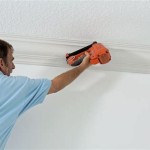Discovering The Best Way To Texture A Ceiling With Roller
Applying texture to a ceiling can completely transform the look of a room, adding depth and dimension to what might otherwise be a flat, unremarkable surface. While there are many different ways to texture a ceiling, using a roller is one of the most popular and easiest methods. If you're thinking about texturing your ceiling with a roller, here are a few things you need to know to get started.
Choosing the Right Texture
The first step is to choose the right texture for your ceiling. There are many different types of textures available, from subtle knockdown textures to more dramatic popcorn textures. The best texture for your ceiling will depend on the overall style of your room and your personal preferences. If you're not sure what type of texture you want, you can always ask a professional for advice.
Preparing the Ceiling
Once you've chosen a texture, you need to prepare the ceiling for application. This involves cleaning the ceiling thoroughly to remove any dirt or debris. You may also need to repair any cracks or holes in the ceiling. Once the ceiling is clean and dry, you can apply a primer to help the texture adhere better.
Applying the Texture
Now it's time to apply the texture to the ceiling. To do this, you will need a roller, a texture brush, and a bucket of texture material. Start by applying a thin layer of texture material to the ceiling with the roller. Then, use the texture brush to create the desired texture. Be sure to work in small sections and overlap your strokes to avoid creating any visible lines.
Drying and Finishing
Once the texture has been applied, it needs to dry completely. The drying time will vary depending on the type of texture and the temperature and humidity of the room. Once the texture is dry, you can paint it or leave it as is. If you're painting the texture, be sure to use a paint that is specifically designed for textured surfaces.
Tips for Success
Here are a few tips for success when texturing a ceiling with a roller:
- Use a high-quality roller and texture brush.
- Apply the texture material in thin layers.
- Overlap your strokes to avoid creating visible lines.
- Allow the texture to dry completely before painting.
- Use a paint that is specifically designed for textured surfaces.

How To Texture Or Retexture Ceilings Danks And Honey

How To Paint A Textured Ceiling First Gen House

How To Texture Or Retexture Ceilings Danks And Honey

How To Texture Or Retexture Ceilings Danks And Honey

How To Paint Your Popcorn Ceilings

How To Paint A Textured Ceiling First Gen House

How To Texture Or Retexture Ceilings Danks And Honey

How To Paint Your Popcorn Ceilings

How To Texture Or Retexture Ceilings Danks And Honey

How To Paint A Textured Ceiling First Gen House
Related Posts








